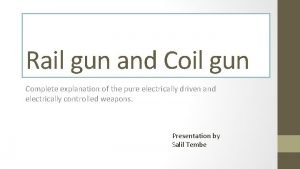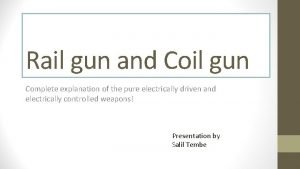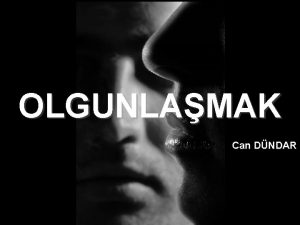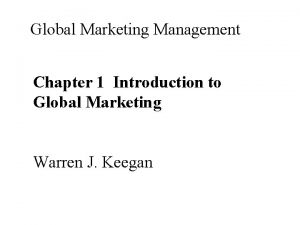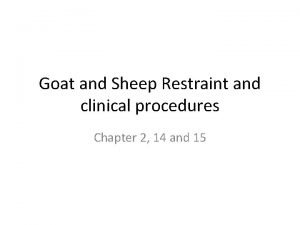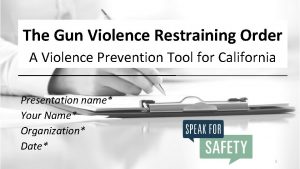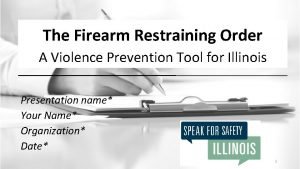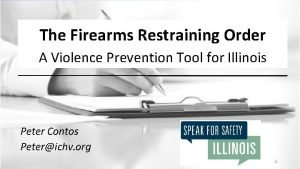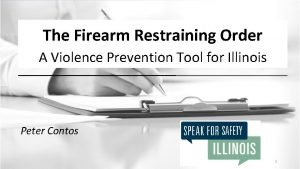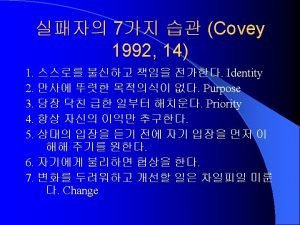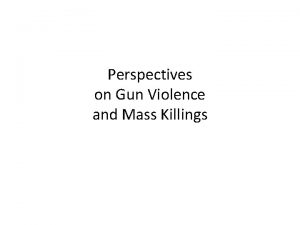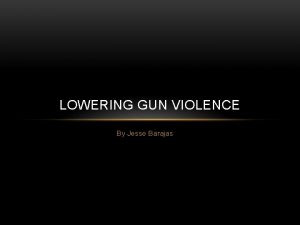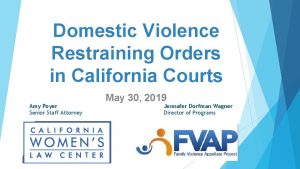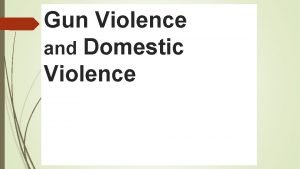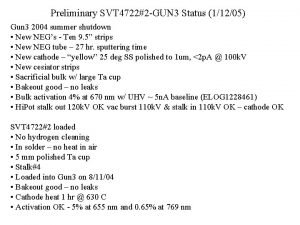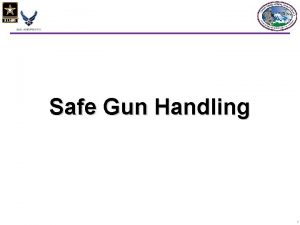The Gun Violence Restraining Order A Violence Prevention









![How Does a GVRO get approved? [Continued] In making GVRO decisions, judges may also How Does a GVRO get approved? [Continued] In making GVRO decisions, judges may also](https://slidetodoc.com/presentation_image/ee132edf0b0798047a50001ae3945fb5/image-10.jpg)






























- Slides: 40

The Gun Violence Restraining Order A Violence Prevention Tool for California Presentation name* Your Name* Organization* Date* 1

Speaker Information Name: Organization: Position/Title: Short bio: (5 -7 sentences) INSERT SPEAKER HEADSHOT 2

What is a Gun Violence Restraining Order? Gun Violence Restraining Orders (GVRO) allow family members, household members, and law enforcement to work with courts to temporarily remove guns, ammunition, and magazines from individuals who pose a significant risk of harm to themselves or others. The GVRO also restricts the restrained individual from purchasing new guns, ammunition, and magazines. 3

How does a GVRO help people in crisis stay safe? The GVRO is a civil procedure, not a criminal one. The goal is to ensure the safety of the restrained individual and those around them by restricting their access to firearms. This creates safer circumstances for the individual to seek treatment, stabilize their behavior, or access resources to address the underlying causes of their dangerous behaviors. Orders can last from 21 days (for emergency & temporary orders) and can be extended to a one-year renewable period after a court hearing is held. 4

History of the GVRO in California’s GVRO law was established after the tragic 2014 shooting in Isla Vista, when friends and family had feared the shooter was dangerous before the shooting occurred, but law enforcement was unable to remove guns from his possession. In the wake of the shooting the 2014 GVRO bill was passed thanks to hard work from many stakeholders and legislators across California. 5

2014 Isla Vista Shooting Isla Vista, CA - May 23 rd, 2014 • A month prior to the rampage, Rodger’s mother, alarmed at some “bizarre” videos Rodger had posted on You. Tube, contacted Rodger’s therapist. The therapist called a mental health crisis service and they referred the matter to police. • 7 killed (including perpetrator) and 14 people injured. • No legal intervention available: On April 30, 2014, police officers arrived at Elliot Rodger’s residence to conduct a welfare check but felt they did not have a legal basis to intervene. 6

AB 1014: Gun Violence Restraining Orders Assemblywoman Nancy Skinner makes push for GVRO Bill AB 1014 on May 28 th, 2014. After amendments and approval by CA Assembly and Senate, AB 1014 is presented to Governor Brown September 10 th and signed September 30 th, 2014 (the last day for Governor to sign or veto). Bill goes into effect January 2016. 7

Steps to Obtaining a GVRO Request a petition from your local Superior Court or download one online. Complete and submit the petition and other necessary paperwork. Note: All Superior Courts in California have selfhelp centers that can provide you with assistance if needed. If the judge issues a temporary GVRO, ask a law enforcement officer to serve the order on the subject of the petition. Attend the hearing scheduled by the court. The hearing will be scheduled 21 days after filing the petition. At the hearing a judge will decide if a one-year order is necessary. 8

How Does a GVRO get approved? Judges make the decision whether or not to issue a GVRO. By law they must consider several indicators of dangerousness: ● Recent threat or act of violence directed toward self or others ● Violation of a protective order currently in effect or unexpired ● Conviction for any crime that prohibits purchase and possession of firearms under California law ● Patterns of violence or threatened violence within the prior 12 months directed toward self or others 9
![How Does a GVRO get approved Continued In making GVRO decisions judges may also How Does a GVRO get approved? [Continued] In making GVRO decisions, judges may also](https://slidetodoc.com/presentation_image/ee132edf0b0798047a50001ae3945fb5/image-10.jpg)
How Does a GVRO get approved? [Continued] In making GVRO decisions, judges may also consider additional evidence of an increased risk for violence, including, but not limited to: ● Reckless firearm behaviors ● History of threatened, attempted, or actual physical force against another person ● Prior arrest for a felony offense ● History of violation of a protective order ● Records demonstrating abuse of alcohol or controlled substances. 10

What is the GVRO Statute? California Code, Penal Code - PEN § 18100 “A gun violence restraining order is an order, in writing, signed by the court, prohibiting and enjoining a named person from having in his or her custody or control, owning, purchasing, possessing, or receiving any firearms or ammunition [including magazines]. ” California Code, Penal Code - PEN § 18107 “A petition for a gun violence restraining order shall describe the number, types, and locations of any firearms and ammunition [including magazines] presently believed by the petitioner to be possessed or controlled by the subject of the petition. ” For more information examine Penal Codes PEN § 18100 - 18500 11

What are three types of GVROs available in California? There are three types of GVROs that may be issued: • Emergency Gun Violence Restraining Order (available to law enforcement only) • Temporary Gun Violence Restraining Order (available to household members, families and law enforcement) • Gun Violence Restraining Order after Notice and Hearing (available to household members, families and law enforcement) 12

Emergency GVRO An emergency GVRO is a type of order that only law enforcement officers can petition for and may be approved orally by a judicial officer even when the court is not open. Emergency orders are generally requested over the phone and then memorialized on a form EPO-002. ● A judicial officer may issue a GVRO once he or she finds that the subject of the GVRO poses an “immediate and present danger” of injury to themselves or others by having a firearm in his or her possession. ● When serving the order, law enforcement must request the subject relinquish his or her firearms, ammunition, and magazines and the subject must do so immediately. ● After filing the GVRO with the court a hearing will be scheduled within 21 to determine if the emergency GVRO should be extended into a one-year GVRO. 13

Temporary GVRO (21 -Days) Family or household members, and law enforcement may file a petition for a temporary GVRO with the Superior Court in the county in which the subject resides during normal court hours. If approved the order will last for 21 days. ● To approve a temporary GVRO a judicial officer must find that the person to be restrained (the subject) poses a “significant danger, in the near future” of injury to themselves or others by having a firearm in his or her possession. ● The Judicial Council of California recommends that all GVROs be served by a law enforcement officer. Officers must complete the service without charging a fee. ● When served the order by law enforcement the subject must immediately relinquish all firearms, ammunition, and magazines in his or her possession. ● A hearing will be scheduled within 21 to determine if the temporary GVRO should be extended into a one-year GVRO. 14

One-Year GVRO When a temporary or emergency GVRO is issued, the court will schedule a hearing within 21 days to determine if a one-year GVRO is necessary. ● Even if the court judge did not issue a temporary GVRO order, the court will still schedule a hearing for the one-year order. ● During the hearing the restrained party has the opportunity to respond to the order, and the court will review the same evidence used when considering the temporary order. The court may also review testimony from the petitioner and any witnesses which they produce, including law enforcement officers. ● If the order is granted it will last one year. ● A one-year GVRO may be renewed up to three months before it expires. A GVRO may not be renewed after it expires. 15

GVROs and Other Restraining Orders GVROs are civil orders specifically designed to ensure safety and allow the person being restrained the opportunity to heal or stabilize away from firearms. There also other types of restraining orders available in California which prohibit someone from accessing guns. If you are concerned about someone being or becoming violent towards themselves or others, you may want to consider talking with an attorney and family or household members about what type of order would be most appropriate for the situation such as domestic violence restraining orders or the 5150 mental health hold. For more information on the different types of restraining orders available visit the Judicial Council of California’s Self-Help page. 16

Firearm Removal Laws in Other States Since the Parkland Shooting February 15 th, 2018, 9 states have approved bills similar to California’s Gun Violence Restraining Order. Bringing the total number of states with Firearm Seizure laws to 14. Many more states are also considering such laws. *Note Graphic does not include Colorado, which has passed a law awaiting the Governor’s signature. Source: State legislatures. Interactive: Daniel Nass. ; Graphic by the Trace 17

Academic Research on GVROs 2017 Duke Study, Jeffrey W. Swanson et al. : ● Examined the results of Connecticut’s firearm seizure law which has been in effect since 1999. ● On average law enforcement removed 7 guns for each order. ● 1 in 3 subjects were given access to mental health care and drug/alcohol misuse counseling– often for the first time. ● For every 10 to 20 orders, at least one suicide was prevented. ● After the Virginia Tech shooting in 2007 the annual number of gun removals increased about fivefold—to about 100 cases per year. 18

Academic Research on GVROs 2018 American Psychiatric Association Study ● Examined Indiana and Connecticut’s firearm seizure laws. ● Indiana’s firearm seizure law was associated with a 7. 5% reduction in firearm suicides in the ten years following its enactment. ● Enactment of Connecticut’s law was associated with a 1. 6% reduction in firearm suicides immediately after its passage and a 13. 7% reduction in firearm suicides in the post–Virginia Tech period, when enforcement of the law substantially increased. ● Risk-based firearm seizure laws were associated with reduced population-level firearm suicide rates. 19

Where are GVROs being used? At least 424 GVROs were successfully petitioned for in California in 2018, with San Diego County leading the state with 185. Southern California Counties have accounted for the majority of orders. 20

We Believe the Current Number of GVROs is Much Lower than the Potential Even as California has seen a positive trend statewide, with the number of orders increasing from 104 in 2017 to 424 in 2018, we believe we have yet to see the full potential for these orders to prevent gun injuries and deaths. Under Connecticut’s extreme risk law, for every 10 to 20 orders issued at least one suicide was prevented. Such an effect would save many lives in California. Rates of suicide have risen steadily in the state since 1999, and rates of suicide among veterans continue to be staggeringly high. 55 percent of California veterans who died by suicide used a gun compared to the statewide rate of 40 percent for the population in general. 21

More Work Needs to be Done in California With the help of their City Attorney, San Diego County has obtained over 185 GVROs when responding to situations including threats of workplace violence, school violence, domestic violence, threats of suicide, and more. However, many rural counties, and counties lacking a local champion, have obtained far fewer GVROs, with 26 counties obtaining no orders at all according to California Dept. of Justice records. In order to maximize the effectiveness of the GVRO, local leaders must work together with law enforcement to help increase understanding and guide them through the sometimes arduous process of obtaining a GVRO. San Diego is conducting trainings across the state, but it takes a long term effort to get procedures in place for local law enforcement agencies to understand how to use GVROs effectively. 22

Who Can Petition: Families/Households If you think there is a strong likelihood that a family member, roommate, or household member would harm themselves or others, petitioning for a GVRO can be an important first step to reduce the risk of harm. If a loved one is experiencing an emotional crisis or is demonstrating signs of being dangerous such as suicidal ideation, aggression, public threats of violence, or unsafe behavior with firearms, you can petition for a GVRO. You may also contact your local sheriff or police department to inform them of an unsafe situation. An example of a scenario where a GVRO could be appropriate: My son has been struggling at college and has alienated himself from his friends. Lately he has been posting violent content online and going to a shooting range. He owns a number of guns, and I am worried that he’s going through a crisis and needs help. 23

Who Can Petition: Law Enforcement If you think there is a strong likelihood that an individual would harm themselves or others, obtaining a GVRO can be a proactive way to prevent violence and protect yourself and your fellow officers if a someone is demonstrating signs of being dangerous such as suicidal ideation, aggression, public threats of violence, or other unsafe behavior with firearms. As a law enforcement officer you can obtain an emergency GVRO, or a 21 -day temporary GVRO. Both orders can be extend to one year and are renewable. An example of a scenario where a GVRO could be appropriate: A local man has threatened his neighbors with his guns, sometimes while he had been drinking. Although he has not yet harmed anyone, the situation has reached a boiling point, and we know from arrest records that he has been violent in the past. 24

Who Can Get Involved? (Attorneys) While only law enforcement, family members, and household members may petition for a GVRO directly, as an attorney, you have an opportunity to advise or assist a client in obtaining a GVRO, such as by helping them fill out the petition. Additionally talking to clients about safe gun ownership and storage is a potentially life-saving action that can help keep them safe. If you are concerned that a client’s firearm usage may become violent or dangerous in the immediate future you may be able to go directly to law enforcement and they may obtain a GVRO if they find it necessary to do so. An example of a scenario where a GVRO could be appropriate: A client's family is concerned that their father, who has shown signs of depression and paranoia, may harm himself or their mother. There are lots of guns on the property, and they are almost never locked up. 25

Who Can Get Involved? (Eldercare) While only law enforcement, family members, and household members may petition for a GVRO directly, as a caregiver, home visitor, or other elder care worker, you have an opportunity to advise a client or client’s family if a client’s usage has become unsafe. Alzheimer’s San Diego estimates that at least 30% of the homes they visit contain guns, many of which are not safely stored. Including information about gun ownership and storage in the paperwork a client fills out can be helpful in keeping clients, and yourself, safe. An example of a scenario where a GVRO could be appropriate: One of my clients is a 91 -year-old man showing signs of dementia. I serve as his companion most days and evening. I know that he keeps two loaded and unlocked guns in his home, and I am worried that he might hurt someone or himself. 26

Who Can Get Involved? (Faith Based) While only law enforcement, family members, and household members may petition for a GVRO directly, as a member of a faith community, you may have an opportunity to connect with a fellow community member or congregation member if they are in crisis, or if someone in their family or household is in crisis or behaving violently. If someone’s gun use has become unsafe, a loved one may seek a GVRO to allow that person to obtain the help that they need away from their firearms. The person then has the opportunity to return to responsible gun ownership once the order expires or is ended by a judge. An example of a scenario where a GVRO could be appropriate: A church member has recently relapsed into alcoholism. His daughter who is also a church member is concerned that there are guns in the home that are unsecured but she is afraid to confront her dad about this in his current state. 27

Who Can Get Involved? (Fiduciaries) While only law enforcement, family members, and household members may petition for a GVRO directly, as a fiduciary or conservator* you have an opportunity to inform a client’s family or law enforcement if a client’s gun usage has become unsafe. Doing so can help prevent gun violence, especially if you are concerned that a client may become violent or dangerous in the immediate future. Including information about gun ownership and storage in the paperwork a client fills out can also be helpful in keeping clients safe. An example of a scenario where a GVRO could be appropriate: A client has become withdrawn and has shown signs of depression and paranoia. There are lots of guns on the property, and they are neither locked up nor properly secured. *If a client is subject to a Conservatorship, the Conservator may file for a GVRO. 28

Who Can Get Involved? (Health Care) While only law enforcement, family members, and household members may petition for a GVRO directly, as a physician or health care provider you have an opportunity to talk to a patient, patient’s family, or law enforcement if a patient’s firearm usage has become unsafe. Doing so can help prevent gun violence or suicide, especially if you are concerned that a patient may become violent or dangerous in the immediate future. Talking to patients about safe gun ownership and storage is a potentially life-saving action that can help keep patients safe. An example of a scenario where a GVRO could be appropriate: A patient has become withdrawn and has shown signs of depression and paranoia. There are lots of guns on his property, and they are neither locked up nor properly secured. 29

Who Can Get Involved? (Mental Health) While only law enforcement, family members, and household members may petition for a GVRO directly, as a mental health professional you have an opportunity to talk to a patient, patient’s family, or law enforcement if a patient’s firearm usage has become unsafe. California’s Tarasoff law allows for a psychotherapist to warn or advise family members or law enforcement of a patient’s dangerous intentions. Doing so can help prevent gun violence or suicide, especially if a patient may become violent in the immediate future. An example of a scenario where a GVRO could be appropriate: A local man has threatened his wife and neighbor as he believes they are having an affair. While the family has been aware of the threats they have been afraid to go to the police. Recently the wife shared this information with a her psychotherapist, but they aren’t sure what they can do. 30

Who Can Get Involved? (Public Health) While only law enforcement, family members, and household members may petition for a GVRO directly, as a public health professional you have an opportunity to help educate community members and families about the GVRO and how it can reduce the potential for danger when someone’s gun ownership has become unsafe. Additionally, if you are concerned that a someone’s firearm usage may become violent or dangerous in the immediate future you may be able to go directly to law enforcement and they may obtain a GVRO if they find it necessary to do so. An example of a scenario where a GVRO could be appropriate: Workers with a local Alzheimer’s care center have experienced several firearm related incidents that could have been potentially dangerous. Some of their clients have dementia and keep unlocked guns at home. 31

Who Can Get Involved? (Veterans) While only law enforcement, family members, and household members may petition for a GVRO directly, as a someone working with veterans you have an opportunity to help educate veterans and families about the life-saving potential of the GVRO when someone’s gun ownership has become unsafe. Additionally, if you are concerned that a someone’s firearm usage may become violent or dangerous in the immediate future you may be able to go directly to law enforcement and they may obtain a GVRO if necessary. An example of a scenario where a GVRO could be appropriate: A veteran in our community recently threatened someone at a party with a firearm while drinking. His friends were able to talk him down but he refused to hand over is firearms. The police have been notified and they are petitioning for a GVRO so the man can seek help away from his guns. 32

What can you do to help? Here are some ways you or your organization can get involved: 1. Talk to your colleagues about the GVRO, and share our handouts and other resources on how a GVRO can be a proactive tool to prevent gun violence (all of which are available online). 2. Host a workshop or webinar featuring information on the GVRO. 3. Include a reference to the GVRO law and Speakforsafety. org in your next newsletter, blog post, or other publication. 4. Invite a Speak for Safety representative to, or use our materials at an event or meeting you plan to host or attend. 5. Follow our Twitter account and “Like” Speak for Safety’s Facebook page to stay up-to-date on news and information on the GVRO which you can share with your network. 6. Other opportunities/ideas? Please email: speak 4 safety@gmail. com 33

Frequently Asked Questions Will there be a filing fee or court fee? Ø No. As of 2019, all court and filing fees have been eliminated for petitioning for a gun violence restraining order. This includes any fees associated with having law enforcement serve a GVRO. (See SB-1200 for more information. ) What if the petitioner doesn’t show up to the court hearing? Ø Then the order will be terminated. Can the subject of the petition contest a GVRO? Ø If the subject of the petition disagrees with the order, he or she may file a response to the court prior to their court date, or they may attend the court hearing and testify against the order in person or in writing. 34

Frequently Asked Questions What's the difference between a GVRO and a Domestic Violence Restraining order or DVRO? Ø A GVRO only prevents the subject of the order from possessing or obtaining firearms or ammunition, it does not bar contact or require that the subject restrict themselves from being near the petitioner. For personal protection from a spouse, family member, or household member, one can proceed under the Domestic Violence Protection Act for a DVRO. The process of obtaining a DVRO is similar to the GVRO but there are different requirements and documentation needed to obtain an order. Once an order is in place it can last up to 5 years, during which time the subject will not be allowed to own or possess firearms. To learn more go to: http: //www. courts. ca. gov/selfhelp-domesticviolence. htm 35

Questions? Visit Speakforsafety. org or email Speak 4 safety@gmail. com Visit Speakfor. Safety. org or email speak 4 safety@gmail. com 36

Blank Slide for Additional Information Insert text. . . 37

Blank Slide for Additional Information Insert text. . . 38

Optional: Video with San Diego City Attorney Mara Elliott 39

Thank You! 40
 Primary prevention secondary prevention tertiary prevention
Primary prevention secondary prevention tertiary prevention Gauss rifle
Gauss rifle Rail vs coil gun
Rail vs coil gun Iyi gunde kötu gunde sözler
Iyi gunde kötu gunde sözler Gun violence thesis
Gun violence thesis Psychological restraint in animals
Psychological restraint in animals Goat restraint
Goat restraint Restraining forces affecting global marketing
Restraining forces affecting global marketing Restraining forces of globalization
Restraining forces of globalization Sheep restraint
Sheep restraint 1st order 2nd order 3rd order neurons
1st order 2nd order 3rd order neurons Cách giải mật thư tọa độ
Cách giải mật thư tọa độ Tư thế worm breton
Tư thế worm breton ưu thế lai là gì
ưu thế lai là gì Tư thế ngồi viết
Tư thế ngồi viết Thẻ vin
Thẻ vin Thể thơ truyền thống
Thể thơ truyền thống Bàn tay mà dây bẩn
Bàn tay mà dây bẩn Các châu lục và đại dương trên thế giới
Các châu lục và đại dương trên thế giới Từ ngữ thể hiện lòng nhân hậu
Từ ngữ thể hiện lòng nhân hậu Diễn thế sinh thái là
Diễn thế sinh thái là Ng-html
Ng-html Giọng cùng tên là
Giọng cùng tên là 101012 bằng
101012 bằng Hát lên người ơi alleluia
Hát lên người ơi alleluia Hổ sinh sản vào mùa nào
Hổ sinh sản vào mùa nào đại từ thay thế
đại từ thay thế Quá trình desamine hóa có thể tạo ra
Quá trình desamine hóa có thể tạo ra Vẽ hình chiếu vuông góc của vật thể sau
Vẽ hình chiếu vuông góc của vật thể sau Cong thức tính động năng
Cong thức tính động năng Thế nào là mạng điện lắp đặt kiểu nổi
Thế nào là mạng điện lắp đặt kiểu nổi Dạng đột biến một nhiễm là
Dạng đột biến một nhiễm là Lời thề hippocrates
Lời thề hippocrates Bổ thể
Bổ thể Vẽ hình chiếu đứng bằng cạnh của vật thể
Vẽ hình chiếu đứng bằng cạnh của vật thể độ dài liên kết
độ dài liên kết Môn thể thao bắt đầu bằng chữ f
Môn thể thao bắt đầu bằng chữ f Khi nào hổ con có thể sống độc lập
Khi nào hổ con có thể sống độc lập điện thế nghỉ
điện thế nghỉ Một số thể thơ truyền thống
Một số thể thơ truyền thống Biện pháp chống mỏi cơ
Biện pháp chống mỏi cơ

